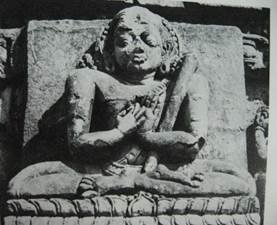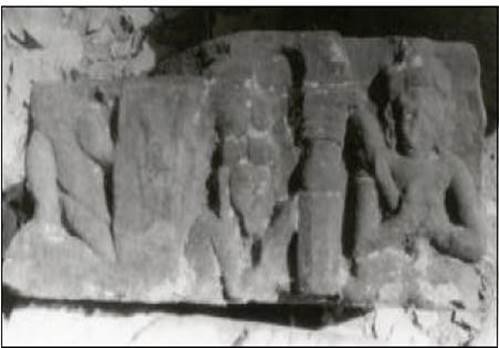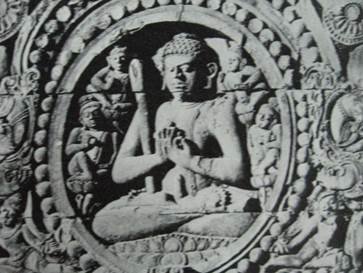Lakulisha-Pashupata (Philosophy and Practice)
by Geetika Kaw Kher | 2012 | 86,751 words
This study discusses the dynamics between the philosophy and practice in the Lakulisha-Pashupata order. According to the cave temples of Elephanta and Jogesvari (Jogeshwari), Lakulisa was the 28th incarnation of Shiva, and Pashupata Shaivism his doctrine, of which the Pasupatasutra represents the prominent text detailing various ritual practices (v...
The Lakulisa-Pasupata activity in Orissa
Orissa comes across as a very important site for Lakulisa-Pasupata order. According to Panda[1]
“It is believed that Lakulisa-Pasupata cult was brought to Kosala and Kalinga in the 4th CE in the train of the military campaign of the Gupta monarch Samudragupta.”
Lakulisa images with Lakuta (club) in hand,seated in Yogasana posture and Dharma Chakra Pravartana mudra (of Buddha) are found in the Parasuramesvara and Bharatesvara temples of Bhubaneswar, which were built in 7th century A.D and the last temple bearing the Lakulisa image in coastal Orissa is the Muktesvara temple of Bhubanesvara which is believed to be architecturally marked by parting of ways between the Bhaumakara and Somavamsi periods. Muktesvara temple is dated to the second half of the 10th centuryA.D. Some of these temples like Parasuramesvara have multiple depiction of Lakulisa, along with the representation of other Tantric deities.
A manuscript of the Visvakarma Vastusastram[2] in the Bhandarkar Oriental Research Institute,Poona gives a prescription for the form of a Lakulisa image,according to which Lakulisa should be represented with urdhvamedhra (ithyphallic),either resting on a lotus seat or in padmasana and holding a citron in his right hand and staff in the left. It also indicates that the Matulinga (citron),an attribute of Lakulisa represents many atoms of the universe.Such figures are common in Orissa, especially in Parasuramesvara temple.
 [Illustration 21. Lakulisa above sukanasi, Parasurmesvara temple, Bhubaneshwar, Orissa,7th CE] |
 [Illustration 22.Lakulisa, Mohangiri, 8th CE,Orissa] |
An interesting variation can be seen from the upper Mahanadi valley of Orissa and to be precise from Mohangiri. Though a late representation,8th CE, the focus in this icon is completely on teaching-learning aspect. In the panel from Dhavalesvara at Mohangiri,Lakulisa is seated in his usual sitting-posture,and to his left, seated figure of a bearded Yogi in profile with folded-hands in obeisance to Lakulisa as well as the figure of a bird seated and staring back are carved. The other yogi as scholars have observed seems to be Kusika, the first and direct disciple of Lakulisa. The panel reveals that the site was dedicated to Atimargika saints who probably believed in the injunctions of Pasupata-sutra because depicting Lakulisa with Kusika points at the transfer of Sutras by word of mouth from Lakulisa to Kusika.
It appears from a study of the existing temples at Bhubaneswar that Pasupatism, Tantrism, Saktism and Saivism all became inseparably mixed up. A strange amalgam is formed in the early medieval period of the then Orissa due to this strange mix up.
In this context the images of Lakulisa seen at Vaital Deul opens up a new area of study where probably one can find links of LP order with Kapalika one. Vaital Deul bears images of Lakulisa and other Tantric deities while the presiding deity is Chamunda. There we find Bhairava, Virabhadra, Amoghasidhi, Gajantakari and the male deity with the head of a boar. Assigned to the Bhaumakara period, the adjacent Siva temple of Sisireswar, bears on it the Tantrik images like Amoghasidhi, Avalokitesvara and Kubera etc,which points at the overlap between Buddhism and Saivism in this region. Particularly during the Bhauma period, a mixed form of religion has been followed by the then Orissa. It appears that in the early medieval period, Saivism cannot be extricated and treated separately. Sakta shrines on the four sides of Bindusagar were established during this period only. They bear the influence of Saivism as much as Saktism. It appears that Saivism took precedence over other sects in the region, atleast during early medieval period upto 10th CE but the kind of Saivism practiced there had a deep influence of Sakta cults.

[Illustration 23. Lakulisa,Vaital deul, mid 8thCE,Bhubaneswar, Orissa]
Tantra had become inextricably mixed up when Somavansis started their rule about 931 A.D. in this region. As per Bhakti Bhagavata a Sanskrit work of Ganga Period, the earth was submerged into the ocean of Tantras during the Bhauma period.
Footnotes and references:
[1]:
Panda Sasanka S, “(Saivacharyas and Foot Print Worship”,Orissa Review Jan 2005)
[2]:
Visvakarma Vastusastram in the Bhandarkar Oriental Research Institute,Poona as quoted by Chobey M.C.p.119
